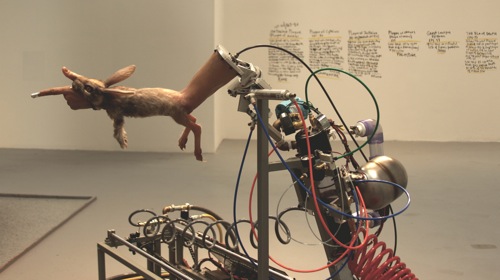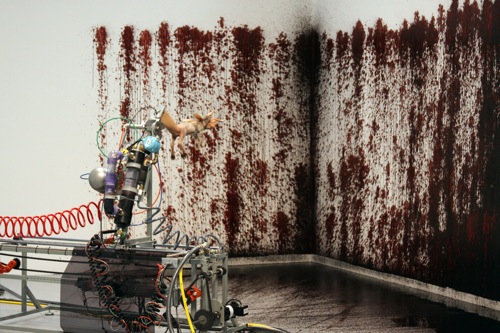Amidst the crowded opening for MOCA's sprawling The Artist's Museum, of all the gossipy conversations and encounters with social network "friends" that took place, the one that got me most excited was the one that Jim and I had about a new work of art that had yet to be released.
This picture and above: Daniel J. Martinez: redemption of the flesh, its just a little bruise; the politics of the future as urgent as the blue sky - 2008, animatronic sculpture with blood, size of installation is variable. Images courtesy of the artist and the Simon Preston Gallery, New York.
All the art world buzzwords were there when Jim told me about this artwork. It was digital art that emphasized artifice as subtext. New Media recontextualizing interactivity allows the viewer to determine the meaning. Experience as simulacra takes place within post-structuralist historical narratives. Elements of performance art have been added to transform the genre. A unique distribution method will ensure this artwork impacts on the wider culture. Collaborations with scientific and engineering advancements are translated into the visual medium. The capturing of motion allows 3-D animation to be used in the service of conceptual space. There was so much to talk about.
First, the $60 million price tag to produce this artwork would buy you dozens of Jeff Koons sculptures and the anticipated $2 billion gross would make Larry Gagosian blush. And to make it even more buzzworthy, it is a hybrid of cinema and fictive persona come alive. And for a youth-obsessed art world, immersing yourself in this contemporary art masterpiece will make you more popular with 19 and 20 year olds than if you were operating a fake ID franchise. Forget trendy street art cretins and ask any teenager; they will tell you this is the art of their generation.
But when this artwork is released on November 9, it won't be at a gallery or a museum. Call of Duty Black Ops, the latest in one of the most successful interactive digital video game franchises in history, will be released as an unlimited edition to the general public via retail instead of as a small edition to collectors in elite exhibition spaces.
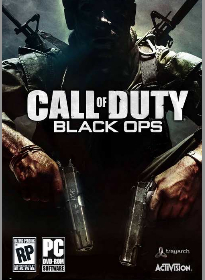
Call of Duty Black Ops video game cover
At the well-attended opening of MOCA's 146-artist strong, The Artist's Museum exhibit, actor James C. Burns and I discussed his starring in the latest installment of the Call of Duty video game series, Call of Duty Black Ops. We were at a comfortable corner of the museum and the more he told me about his performance in the latest Call of Duty, the more it seemed to be reflected by the unique spot of the museum in which we were standing.
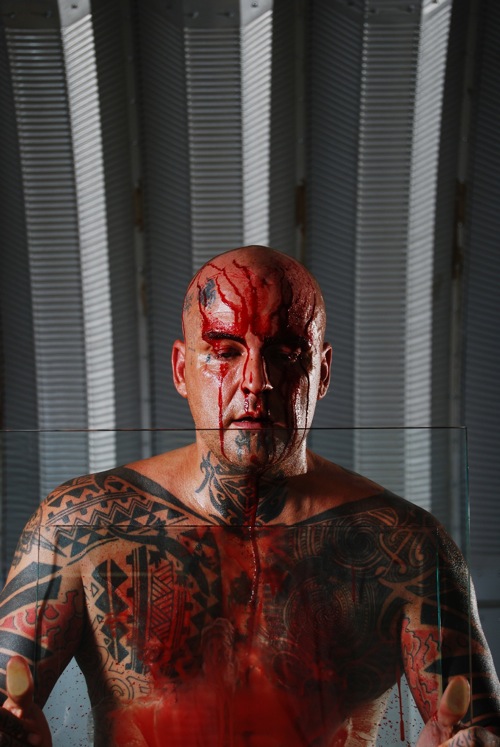
Ron Athey Self-Obliteration #1: Ecstatic, 2008 C-print, 30 x 20". Courtesy of the artist and Western Project
The MOCA show is organized in a loose, thematic manner that bunches artists together with associations of context and era - with the simple assertion that each of the artists has made a name for themselves in L.A. since the early 1970s. To our right hung a Ron Athey self-portrait photograph, tattooed and bleeding, presumably after he had ritually bloodlet himself in one of his signature über-impact performances. Entitled Self-Obliteration #1: Ecstasy, there was more emotion in Athey's serene concentration on a pane of glass in front of him than in the last two decades of MOCA's curatorial platitudes. As Burns discussed building his performance in the video game as "Woods", a fearless Rambo-type soldier who guides players on secret murderous missions set in mid-sixties Vietnam, it was as if MOCA was recognizing a world audience that understands that our taboos on violence might be what beget violence. Ninety years after Malevich, all geometric abstraction can be accused of amounting to nothing more than a collective denial of a world creating its own destruction. The inclusion of Athey may signal some turning point. The millions of video game junkies could be said to be ahead of the curve.
The advances in video game technology have come a long way since I dropped my final quarter on a date with Ms Pac-Man. The realism is hypnotic and the many levels of activity that require one to pay attention surpass cinema at its most complex. Near the Athey were two other artists that are far from MOCA's short-list. Robert Williams is in his sixth decade of using cartoon composition and illustration techniques to revive painting as a fine art object that carries more conceptual weight than the mere words and gestures of classic conceptual art. Meanwhile, a self-confessed Williams protoge, Mark Ryden, hangs on the same wall as Williams with a hyper realistic painting of an indecipherable fantasy world. The infinite levels of high, low and hypothetical on which Williams is operating and the rigorous realism in the service of fantasy that is Ryden's trademark underscore where art is fearlessly going outside of the academy. Like Athey's fetishization of violence, these two artists mine fertile territory in the visual and conceptual sphere that also finds its outlets in popular culture with all-consuming video games; and in The Artist's Museum, they serve up more pictorial energy and brilliance on one wall of MOCA than the institution displayed during the entire Jeremy Strick regime.
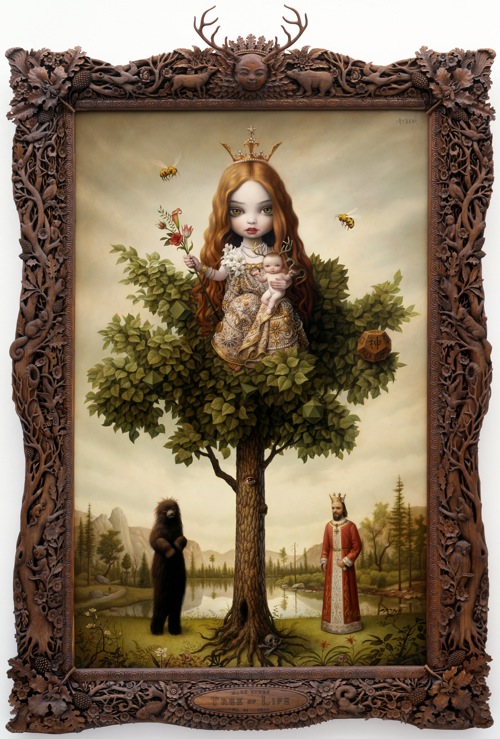
Mark Ryden The Tree of Life No. 63, 2006, 84 x 56 1/2", Oil on canvas with artist made frame. Courtesy of the artist and Michael Kohn Gallery
Whether or not MOCA is leading or following relative to the wider culture is irrelevant. What shows like The Artist's Museum indicate is that MOCA director Jeffrey Deitch is willing to ignore the pseudo-canon of MOCA's pet artists in favor of the art of our times. This show jumbles everything together and so much of what we have been subjected to as museum visitors in the past three decades is found wanting next to new discoveries and overlooked masters.
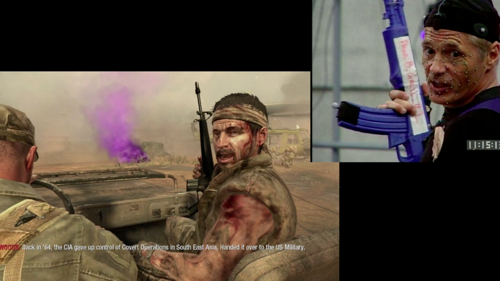
James C. Burns in "performance capture" as Woods
Burns and I and our dates took the opening night shuttle to MOCA's Geffen wing and I couldn't get enough Call of Duty gossip. Information on a game before its official release is currency in some circles. As MOCA undergoes a welcome change in its mission, Burns describes how his character, Woods, guides players on their Call of Duty Black Ops "missions". Looking around at The Artists' Museum, one can imagine that Jeffrey Deitch will be "taking out" some big legacies to make room for a rewritten art history. At the Geffen wing, your mission is to find memorable art amidst the jumble of highlights and lowlights dancing large, like a 3-D stamp collection demanding you play "the name game".
As so much of the art of the 1990s MOCA recedes into inconsequentiality, the presence of new forms of entertainment such as Call of Duty might seem to challenge high art. But at the Geffen wing, one is reminded that amidst the detritus of trustee investments, the intimacy of occupying the same space as a great object has to be simulated in 3-D or any number D. The best piece in The Artist's Museum is easily the hypnotic mechanical nihilism of a masterful Daniel J. Martinez installation, "redemption of the flesh, its just a little bruise; the politics of the future as urgent as the blue sky", a 2008 animatronic sculpture that squirts what appears to be blood onto the walls of the museum. Behind this carnage are hand-scrawled recounts of the known plagues of history that have taken a million or more victims each.
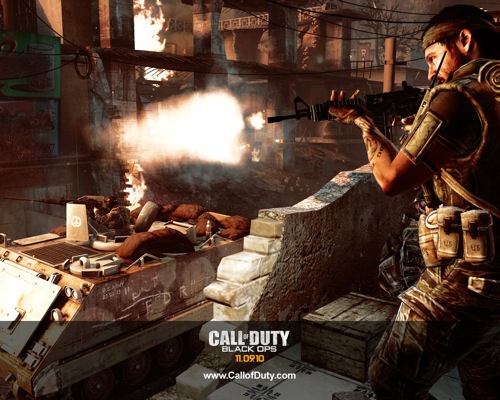
Call of Duty Black Ops. This and all COD images Courtesy of James C. Burns
Ask a teenager what playing Call of Duty Black Ops for sixty hours is like compared to a five minute round of Galaga or Space Invaders. There is no comparison except on formal grounds. And there you have the same answer for why MOCA even bothered to place this Martinez masterpiece among the clutter of boring 1990s art that has been the bread and butter of a formerly dull institution. Let's hope that Jeffrey Deitch can be like James C. Burns' character Woods and guide our museum of contemporary art to answer its own call of duty, giving the public great art that engages its viewers.
Daniel J. Martinez: redemption of the flesh, its just a little bruise; the politics of the future as urgent as the blue sky


